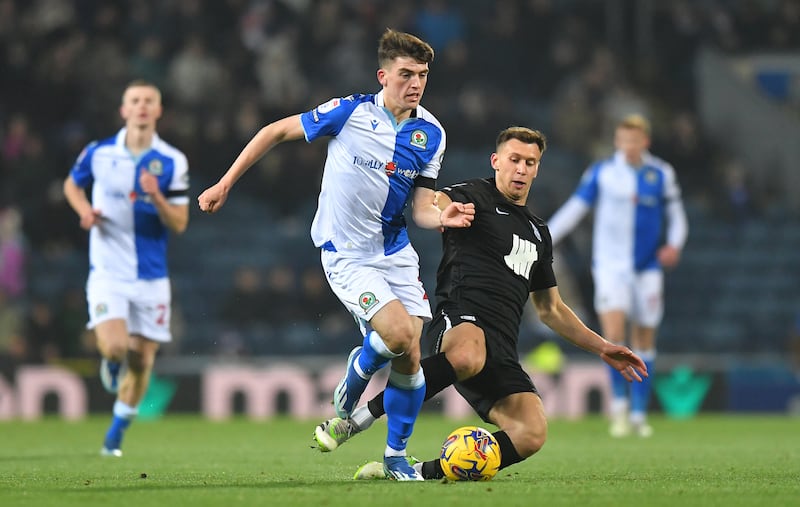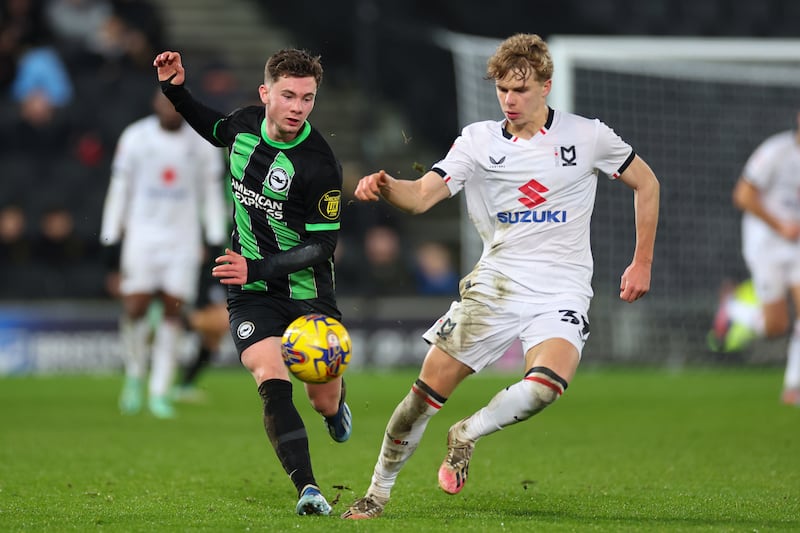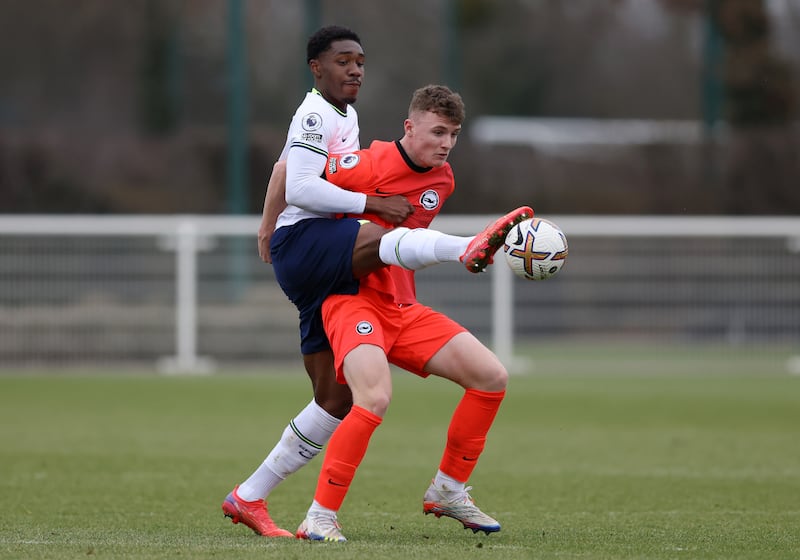A special piece of Ireland, verdant and valuable, can be found in the unlikely setting of Lancing, in West Sussex, behind a rundown-looking hand car wash centre.
The journey there is hardly propitious. A long, winding lane appears to be heading nowhere. Huddles of houses press into each other, like mourners seeking comfort and warmth at a chilly funeral.
And, suddenly, there it is: the American Express Elite Football Performance Centre, Brighton and Hove Albion’s £30m state-of-the-art training complex that includes 18 pitches, a luxury spa where the shower options include Tropical Rain, Side Nozzles, Cold Mist and Caribbean Storm and a restaurant where breakfast choices incorporate seven different flavours of porridge and the lunch menu rivals the city’s top eating spots.
Coach Gary Dicker greets us at the end of our trip – 12 miles West of Brighton – with a smile and a wink: “I think we’re going to change the name of the club to Brighton and Hove Ireland,” the Dubliner says.
RM Block
Brighton is the home of the UK’s solitary Green Party MP, Caroline Lucas. But it’s the other green party which is creating more excitement in the city. The local football club now rivals Liverpool and Manchester United, the traditional destinations for outstanding Irish talent.
And this forms a pivotal part of what is widely considered to be the best-run club in the Premier League, with a staff of over 400. Their attention to detail is such that they even have separate coaches for when the players have possession, and when they don’t.
Leading the Irish contingent is Evan Ferguson, the most talked about young striker in the land, the teenage sensation who wanted to be a postman but is now, according to Brighton’s head coach Roberto De Zerbi, destined to become “the top scorer in Europe”. According to former Newcastle United and England striker Alan Shearer, “Ferguson has everything”.

The young Ireland striker won the RTÉ Sport Young Sportsperson of the Year award earlier this month and recently extended his contract with the club until 2029. That means nothing – just that he will go for even bigger money when he moves to a top club. It is predicted his sale will smash the British transfer record, the £115m that Chelsea paid Brighton for Moises Caicedo.
But Ferguson is just the best known Irishman at Brighton. Fellow striker Mark O’Mahony has signed from Cork City. Andy Moran – currently on loan to Blackburn Rovers – and Leigh Kavanagh have come from Bray Wanderers, Killian Cahill is from Shamrock Rovers and Jamie Mullins, like Ferguson, played for Bohemians.

Two of the Ireland’s great players had associations with Brighton. Mark Lawrenson played for the club (1977-81) before finding fame and fortune with Liverpool and Liam Brady managed the club (1991-93) after his glittering career with Arsenal and Juventus. There have been other Irishmen too, but not in today’s numbers.
“The club’s being run by the Murphia,” one supporter quipped the other day.
“We’ve got the biggest number of Irish lads we’ve ever had,” says Dicker. “It goes back to when John Morling was the last academy manager.”
Morling was with Brighton from 2012-22 before returning to the FAI.
“John had worked with the FAI before and knew the Irish set-up. And then Leroy McCourt spotted a lot of talent.”
McCourt, brother of Celtic’s “Derry Pele” Paddy McCourt, travels Europe on Brighton’s behalf but scouting for Irish talent is his speciality. Current head of academy Ian Buckman says: “Leroy does a lot of great work for us and keeps an eye on all the players.”

Dicker, 37, was a thoughtfully busy midfielder who had a typically peripatetic career, leaving Brighton to play for Rochdale, Crawley and Kilmarnock – where he captained and coached the reserves – before returning to the south coast club as player-coach of the Under-23 side.
He then managed the Under-18s before becoming assistant manager of the Under-21s, under Shannon Ruth. He played for Ireland several times, but never at full international level. Like most good coaches, he was not a special player.
Brighton is not so much a phoenix risen from the ashes as a seagull that has caught miraculous thermals, lifting itself from near football oblivion to the heights of the Premier League.
At the end of the last century they were within one game of being relegated from the Football League. Several difficulties followed, including a tortuous ground-sharing spell with Gillingham.
They were saved by former chairman Dick Knight but it was when he was replaced by Tony Bloom in May 2007 that the club started to seriously overachieve, moving to a new stadium, the Amex, in 2011 and reaching ninth place in the Premier League in 2021-22 under Graham Potter.
Potter was popularly regarded as the best manager in Brighton’s history. But De Zerbi has proved an upgrade, playing even more attractive football, scoring more goals and finishing sixth last season, as the team qualified for Europe.

Earlier this month Brighton beat Marseilles 1-0 to top their Europa League group, which also included AEK Athens and four-times champions of Europe, Ajax.
The game was watched by former Liverpool and England forward Michael Owen, who said: “Brighton is everybody’s favourite second team, a club that gives everyone hope. The story, what they’ve gone through, the chairman, the new stadium, the fan base, the way they play ... everything about the club is pure class. And it couldn’t happen to a nicer club. No one will fancy playing them in the last 16 of the Europa because they’re a passing side who can make any team look stupid.”
Brighton’s secret is that they buy cheap, using sophisticated data-based analysis to identify players, and sell expensive. Their attractive playing style is based on possession-based football, playing from the back, drawing the opposition towards them and then working through the lines with fast and precise first-time passing.
“The whole club, the different sides here, all play the same way,” says Dicker. “It comes down from the chairman and the manager. It won’t change. So when a new manager comes in you’re not ripping up the book and starting again. The transition is easier. Coming to Brighton is the best education I’ve had.”

“The best thing I’ve seen here is what people don’t see. Training looks like a game. When I look at Brighton play at the Amex, that’s the same way they play out here on Monday and Tuesday morning. It’s how the manager sets up and manipulates the team to do what he wants. It’s the best.
“It’s quite complicated but has great simplicity as well. He wants the ball for 90 minutes. And as a player that’s the best thing you can feel. Having a plan, having a style of play, an identity and having the backing of the manager. It takes a lot of bravery to play like that because you’re always five games away from getting the sack.
“So, to have the courage to give that to the players, to explain it, to show it and deliver it, that’s fantastic. That’s the hardest thing to do as a coach. He’s got loads of charisma and personality. He knows when to give a player a hug or a good talking to. And he’s set high standards for everyone.”
Dicker’s only regret is that he doesn’t have more time to spend in his Dublin home, near Tallaght, in the shadow of the Dublin mountains.
“I’ve probably lived over here as long as I was in Ireland. I miss my friends, miss a night out back home. But my bank balance doesn’t!”
Mark O’Mahony: next off the production line?

Mark O’Mahony, the striker who started out with Cork City, is already being talked up as the replacement for Evan Ferguson when the former Bohemian moves to a bigger club, which he inevitably will.
O’Mahony, who has played for the Republic of Ireland at Under-17, 18 and 19 levels, signed for Brighton in January 2023 and his goals for the Under-21 side have pushed him on to the first team bench in recent games.
“Obviously I want to get on the pitch, but just being around these players is an experience in itself,” he said. “It’s feels unreal. It’s so exciting to be involved with Brighton at this time, with the way they’ve progressed in recent years, and to a large extent they’ve done so by giving young players a chance. I’m really enjoying myself.”
O’Mahony lives just a two-minute walk from the training ground.
“It might be three minutes on a slow day. I’m great pals with Jamie Mullins. I knew him from Ireland and now live next door to him. Having him here helped settle me down. Not a lot of players come over from Cork, which makes it harder, but it’s been great.”
Brighton’s Under-21s assistant manager Gary Dicker says: “Mark came here on trial and we made up our minds about him on day one. He came here and worked his socks off, always wanted to be better. He scores goals, and that’s the hardest thing to do in football. I couldn’t do it. And he’s a really nice lad. That’s important here, the type of person you are.”
O’Mahony says: “There are still things I need to improve on, the tactical stuff, positional things, running in behind defenders. Harry Kane was always the forward I looked up to as a kid. I try to play in a similar way to him, a number 9 but also a bit of a 10.”
Brighton’s Irishmen
Gary Dicker, coach.
Evan Ferguson, forward.
Mark O’Mahony, forward.
Jamie Mullins, midfield.
Andy Moran (on loan to Blackburn) midfield.
Leigh Kavanagh, defender.
Killian Cahill, goalkeeper.





















